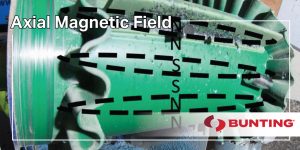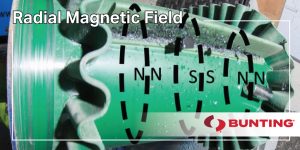Get in touch with us at our toll-free number 1-800-835-2526 or request a quote here:
What is an Axial and a Radial Magnetic Field?
Bunting manufactures several varieties of magnetic separators classified as rotary magnetic separators, including our Drum Magnet. Rotary magnetic separators are designed with a specific type of magnetic field, which is considered when evaluating an application in order to decide which design will best achieve a customer’s separation objective. For rotary magnetic separators, there are two types: Axial and Radial Magnetic Fields.
Below, we will explain axial and radial magnetic fields, as well as explaining why the differences between the two are so important.
Axial Magnetic Field

Axial magnetic fields stretch across the width of a rotary magnetic separator. When magnetically susceptible material enters the field, it is attracted to the point of highest magnetic intensity—known as the pole—but then, the motion of the conveyor or drum drags the material through a weaker area of field located between the two poles before it eventually settles onto another pole.
An axial magnetic field is ideal in situations where the magnetic separator may have captured a high level of entrapped non-magnetic material. Because of the motion of movement between the poles, non-magnetic material will be released as the magnetic item “tumbles” in the field. The downside of this type of magnetic field is that there is the potential for reduced separation performance.
An axial magnetic field is best for applications where the separation objective is to maximize the purity of the recovered ferrous metal. An example of an application that may prioritize the purity of recovered material is an auto recycling application where the purity of ferrous material recovered is essential in determining its resale value. This is because the “tumbling” effect is able to release entrapped non-magnetic material. However, this means that recovery rates of ferrous metals may be slightly lower.
Typically, magnetic separators using an axial field can be found recovering ferrous metal from recycling operations. Bunting products that can utilize axial magnetic fields include permanent drum magnets, electro drum magnets, and pulley magnets.
Radial Magnetic Field

In a radial magnetic field, poles are running in the same direction that the conveyor or drum is rotating, and follow the flow of the material. Magnetically susceptible material will be attracted to the poles, which are the highest points of magnetic intensity, and held there until it is dragged out of the magnetic field.
A radial magnetic field is ideal when the goal is to maximize the amount of magnetic metal being separated from material. An example of an application that may seek to separate the maximum amount of magnetic metal is in a mineral application where ferrous tramp metal must be removed from the product stream, so as not to contaminate the product. The downside of a radial magnetic field is that it is possible for entrapment of non-magnetics to occur, which then reduces the purity level of the recovered metal that is ultimately separated out.
Magnetic separators with radial magnetic field design are typically found in applications such as recovering magnetic minerals in mineral processing, and also applications such as removing ferrous metals in certain recycling applications.
Bunting products that can utilize radial magnetic field design include drum magnets, pulley magnets, rare earth roll separators, and induced magnetic roll separators.
Selection Criteria
When you are deciding the type of magnetic field to use in a specific application, it is important to consider key factors, including:
• Capacities that commonly determine burden depths.
• Separation objective—are you seeking to prioritize recovery or removal of ferrous materials as your main separation goal?
• If you are prioritizing recovery, consider your purity target for the metal you are recovering.
• If you are prioritizing removal, consider the separation target of the ferrous component.
• What is the particle size of the ferrous metal and non-metallic metal you are handling?
In Summary
For a metal recycling operator, an axial magnetic field produces cleaner ferrous metal, but results in a lower recovery rate due to some ferrous falling out with the non-ferrous material. A radial magnetic field produces more ferrous metal that is less clean as some non-ferrous material is removed along with the ferrous.
For additional information about our magnetic separators, assistance in selecting the best magnetic separator for your application, and to learn more about axial and radial magnetic fields, contact us today.
